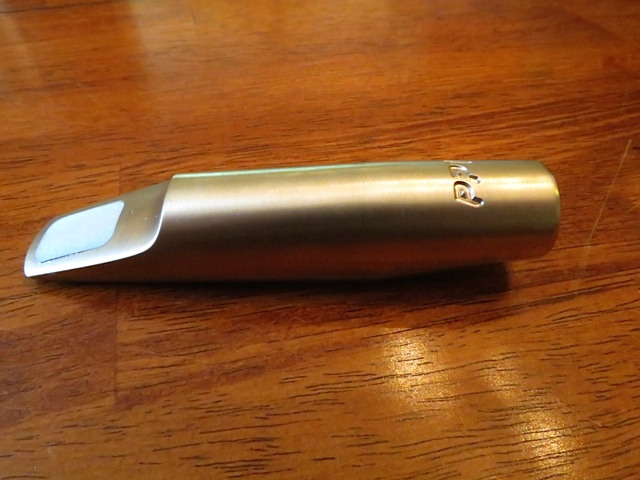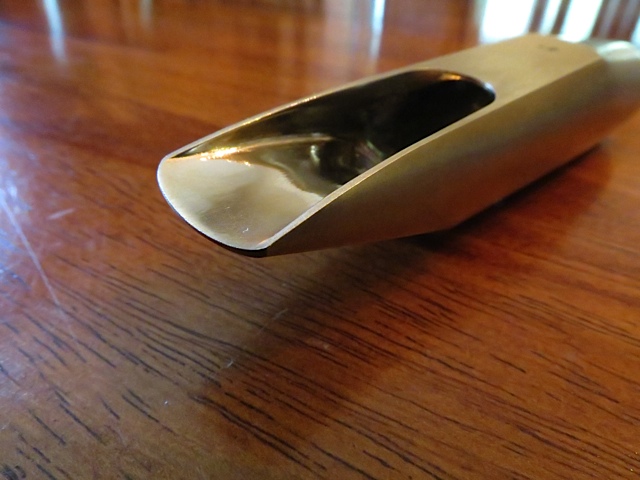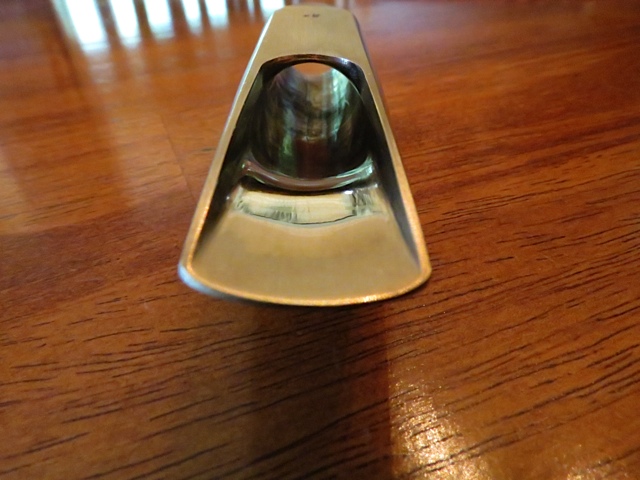This is a new metal tenor saxophone mouthpiece by Pete Thomas. The PPT metal mouthpieces have similar internal dimensions to the Onyxite PPT that I reviewed a few years ago. The facings are based on Ed Pillinger’s original facings, and are machined from solid brass. They are then hand finished by Morgan Fry. Morgan Fry is a great mouthpiece refacer over in England. This tenor saxophone mouthpiece is the brushed gold mouthpiece and looks beautiful.
Pete Thomas PPT Metal Tenor Mouthpiece
The mouthpiece I received to review is a 8* and is absolutely beautiful. I really like the brushed gold finish of the piece as it gives it a bit of a vintage look. The design of the mouthpiece is unique in that the body and bore of the mouthpiece all seem to be one flowing design. There are no lines to separate them so it gives the mouthpiece a very modern look. The tip and rails are very thin and precise. It looks to have a normal sized window on it. The metal PPT has a high baffle on it much like the Onyxite PPT I reviewed a number of years ago. The baffle has a high plateau to it that slopes down into a scooped large chamber with scooped sidewalls.
Pete Thomas PPT Metal Tenor Mouthpiece
You can see the high baffle in the picture below. My first thought was that this mouthpiece was going to be loud and extremely bright. The PPT Onyxite I had bought for the last review played great (that’s why I bought it) but in the end I felt it was leaning too far to the bright side of things for my personal tastes. I expected this new metal PPT mouthpiece to be similar to that Onyxite mouthpiece.
Pete Thomas PPT Metal Tenor Mouthpiece
The factor I forgot to account for was the tip opening. Whereas the Onyxite was a 7* tip, this metal PPT mouthpiece is an 8*. The tip opening is a major factor for high baffled mouthpieces. A high baffle speeds up the air being blown through the mouthpiece so that the sound can be louder and many times brighter when you push it. It seems like a closer tip opening brings the reed closer to that high baffle and the sound is brighter. When you play the same model mouthpiece in a larger tip opening many times the tone is less bright. I’m not sure of all the acoustical and design reasons for this but I have experienced it many times. I was nicely surprised by the metal PPT mouthpiece. I used a Vandoren Java 2 1/2 reed on it with a Selmer 404 metal ligature. It was not as bright as the Onyxite 7* I had played but it still had a nice thick sound to it with lots of character. It is still much brighter than a lower baffled piece like an Otto Link but you can listen to the clip below and judge for yourself. I did feel the tone had a dry character to it. I’ve played other mouthpiece with this same characteristic like my Theo Wanne Gaia alto mouthpiece. When I listen to this clip of the PPT it sounds dry to me. I’m not saying this is good or bad…….just a word I would use to describe the tone. Because of the larger tip and high baffle, you can get tons of volume out of this mouthpiece so it would be great to use in a rock or blues band. It was also very easy to get the altissimo notes and the intonation was great on the mouthpiece.
Pete Thomas PPT Metal Tenor Mouthpiece
I really enjoyed playing the Pete Thomas PPT Metal Tenor Mouthpiece. If you like the sound and look of this mouthpiece contact Pete Thomas . There are some more mouthpiece clips of the PPT metal and Onyxite side by side so you can compare them next to each other.
I would also like to add that all of Pete’s profit from the sale of these PPT mouthpieces as well as other endeavors on his website are contributed to charity. He has given thousands of dollars over the years to APEC, LeukemiaBusters, Red Cross, Band on the Wall and now Gorton Education Village. It’s great to see another sax player and teacher giving so much of himself to further music and the saxophone and at the same time giving so much to those who need it. Great job Pete!
Let me know what you think in the comments below. Thanks, Steve
Pete Thomas PPT Metal Tenor Mouthpiece








Steve, I really like your tone with this mouthpiece. Did you use any reverb or effects? Just wondering I think the piece has a great versatile fat tone…of course much is due to your ability as a player too!
Thanks Mark. No effects. I record all the review clips totally dry.
Steve
Have you compared this PPT metal mouthpiece to the equivalent PPT standard (non metal) ? I have a PPT plastic that I really like but it’s rather large in its outer dimensions. I am wondering if the equivalent metal PPT plays and sounds the same as the non-metal. I assume that the inner chambers are equivalent. Do you have any comments or experience on that?
Nice playing Steve
Hi Steve,
thankYou for another great review! With Morgan Fry involved in the finishing and plating, there are similarities concerning baffle/chamber-concept. How would You compare the PPT to Morgan Fry’s Rhodium plated large chamber Tenor piece?
Walter, the Rhodium MF piece had a rounder, darker, sweeter sound than the PPT. Not as much power. The PPT was definitely brighter and more powerful. It wasn’t Guardala bright but had a more of a thicker tone to it than a Guardala………hope this helps. Steve
I was fortunate to get a mint condition 9* metal mouthpiece about 5 years ago for less than half of its retail price. I’ve been using as my main mouthpiece since I got it but it’s had to face some strong competition from 3 different Ponzols, 3 Bergs and a metal .120 Boss mpc.
I just recorded a CD using this mpc on one of my Super 20s. It’s on the bright side of the spectrum but if I think fat, low and breathy I can achieve that. I like the Boss a lot too but the altissimo is blood curdling intense on the PPT and good but not great on my Boss. The PPT is very worthy of consideration for anyone considering this type of mouthpiece. It’s not very well known and I think more people would be using these if it wasn’t a mouthpiece that you buy off a website in Great Britain.